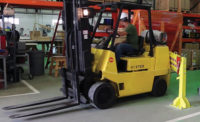How to avoid load dock injury in the warehouse

Credit: LongHa2006 / Getty Images Plus
The combination of large vehicles, heavy machinery, uneven terrain and large loads make the loading dock dangerous for warehouse workers of all kinds. Dockworkers, truck drivers and employees that work elsewhere in the facility must exercise caution when in this area.
Around one-quarter of all warehouse injuries happen on the loading dock. Even with good warehouse safety practices, you’ll need a plan that manages the specific risks that come with this aspect of the job.
The right combination of loading dock safety strategies can go a long way in preventing injuries and keeping a facility’s dockworkers safe.
Common causes of load dock injury
- Slips due to wet, slick or oily surfaces
- Falls from and around the dock edge
- Injury from forklifts or other warehouse equipment — for example, an employee is caught by a forklift’s rear swing
- Trauma from delivery trucks
- Musculoskeletal injuries (MSIs)
Mitigating these risks is the best way to prevent injuries on and around the loading dock.
In general, practices that make a warehouse safer will also help you reduce dock injuries. For example, teaching employees how to lift heavy boxes will help keep them from developing MSIs, whether working in the warehouse or on the dock.
However, warehouse safety training that also covers risks specific to the dock is also necessary. When developing or reviewing your curriculum, you should make sure it covers dock safety and potential loading dock hazards.
For example, a portion of the training may cover the hazards of working around large delivery trucks — and how mistakes like misplaced or loose vehicle restraints can lead to serious injury. Another might cover the risks of dock jumping.
Employees operating heavy machinery, like forklifts, should also be aware of the safety risks they can pose around the dock. There may be accidents in tight spaces or near ledges or hazards when backing up to the edge.
Improving dock safety with equipment
Safety equipment and simple upgrades to a dock can also make a major difference. For example, warehouse workers can fall due to a slippery surface, a lack of visual indicators that mark the edge or faulty equipment, like an unsecured dock plate.
Safety mats can help prevent falls by reducing the potential for slips due to the buildup of moisture or oil. Combined with regular cleaning of spills, these mats can help keep workers from falling. High-visibility tape, signage and other safety markings can make the edge of the dock clearer, reducing the risk that a worker doesn’t notice it.
More advanced safety solutions, like a restraint system that lets dock workers know when a vehicle isn’t secure, can provide additional protection.
Other safety considerations for warehouse managers
Winter weather and rain can also pose challenges for warehouses. These elements can lead to slippery surfaces that may cause falls and accidents involving forklifts and lift trucks. The reduced visibility that can come with shorter days and cloudy skies may also make the dock a more hazardous working environment.
To reduce the safety risks that winter weather and the elements can cause, try to minimize the amount of time dock doors are open. Equipment like safety mats, rain shrouds and air curtains can help reduce the potential for slips, falls and similar accidents.
Some warehouse safety managers also invest in fans that can keep moisture from building up or freezing on dock walkways.
If one or more loading docks in your warehouse are enclosed, you should also consider the risk for carbon monoxide poisoning. This gas can build up quickly and lead to headaches, dizziness, and sickness of death. Carbon monoxide poisoning is a major risk around docks due to the combination of exhaust from heavy machinery and large delivery trucks.
Building ventilation is key in keeping workers safe. Awareness of the signs of carbon monoxide poisoning will also be essential.
Regular maintenance of lift trucks and similar equipment can help keep their carbon monoxide emissions low or more manageable. Certain fuel additives and parts that manage a machine’s fuel/air ratio can also help.
In areas where carbon monoxide buildup is a concern, like poorly ventilated docks, the installation and maintenance of detectors can provide another valuable safeguard.
Preventing injury on and around load docks
Load docks are a common site for warehouse injury — and even if a warehouse has good general safety practices, certain risks may be overlooked. That’s why it’s vital to conduct regular safety inspections and ensure all workers are following protocol.
Preventing load dock injuries is possible with the right combination of practices and equipment. Awareness of common issues — like falls, slips and equipment accidents — can help any warehouse safety manager adopt the tools they need to keep workers safe.
Looking for a reprint of this article?
From high-res PDFs to custom plaques, order your copy today!







